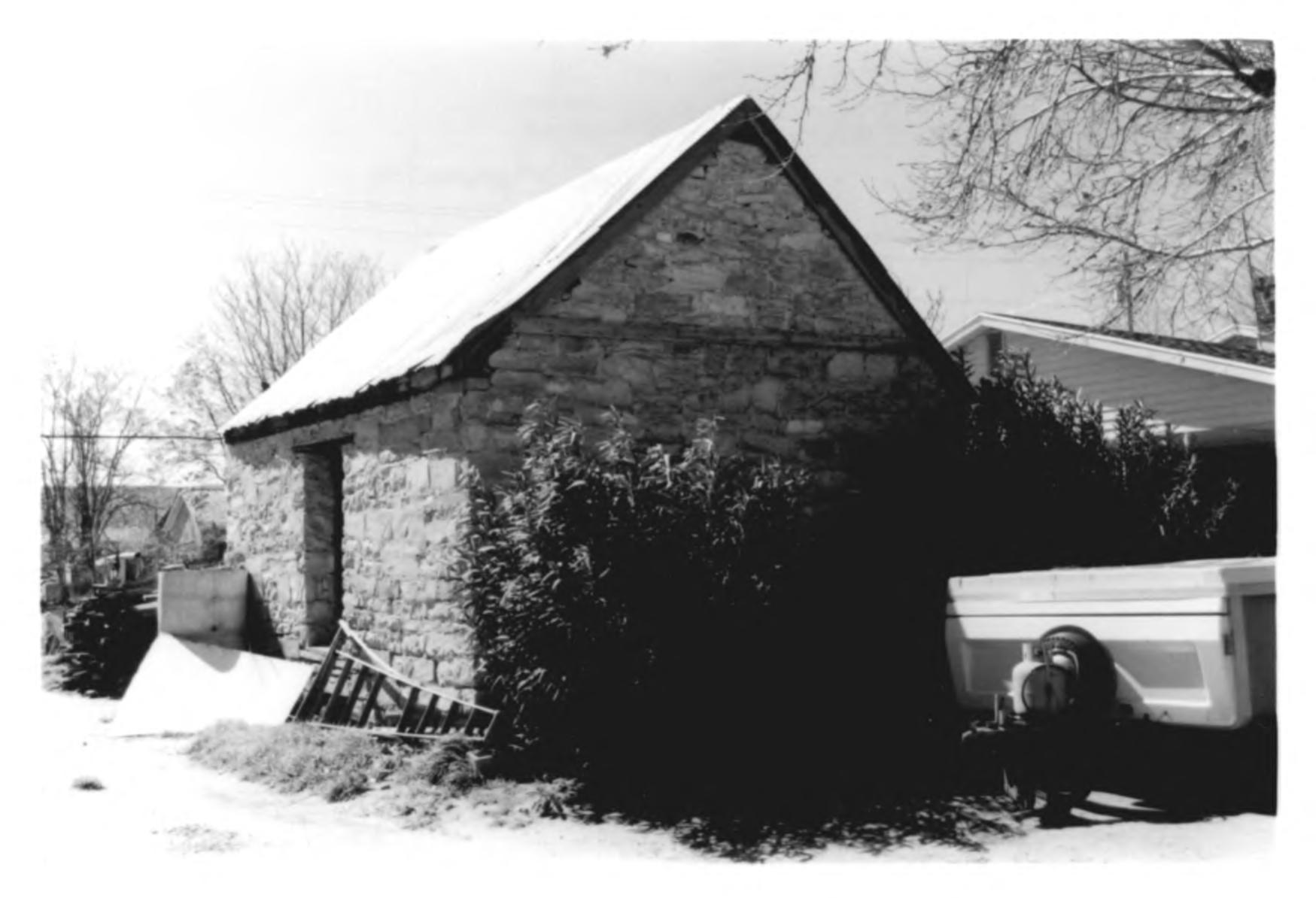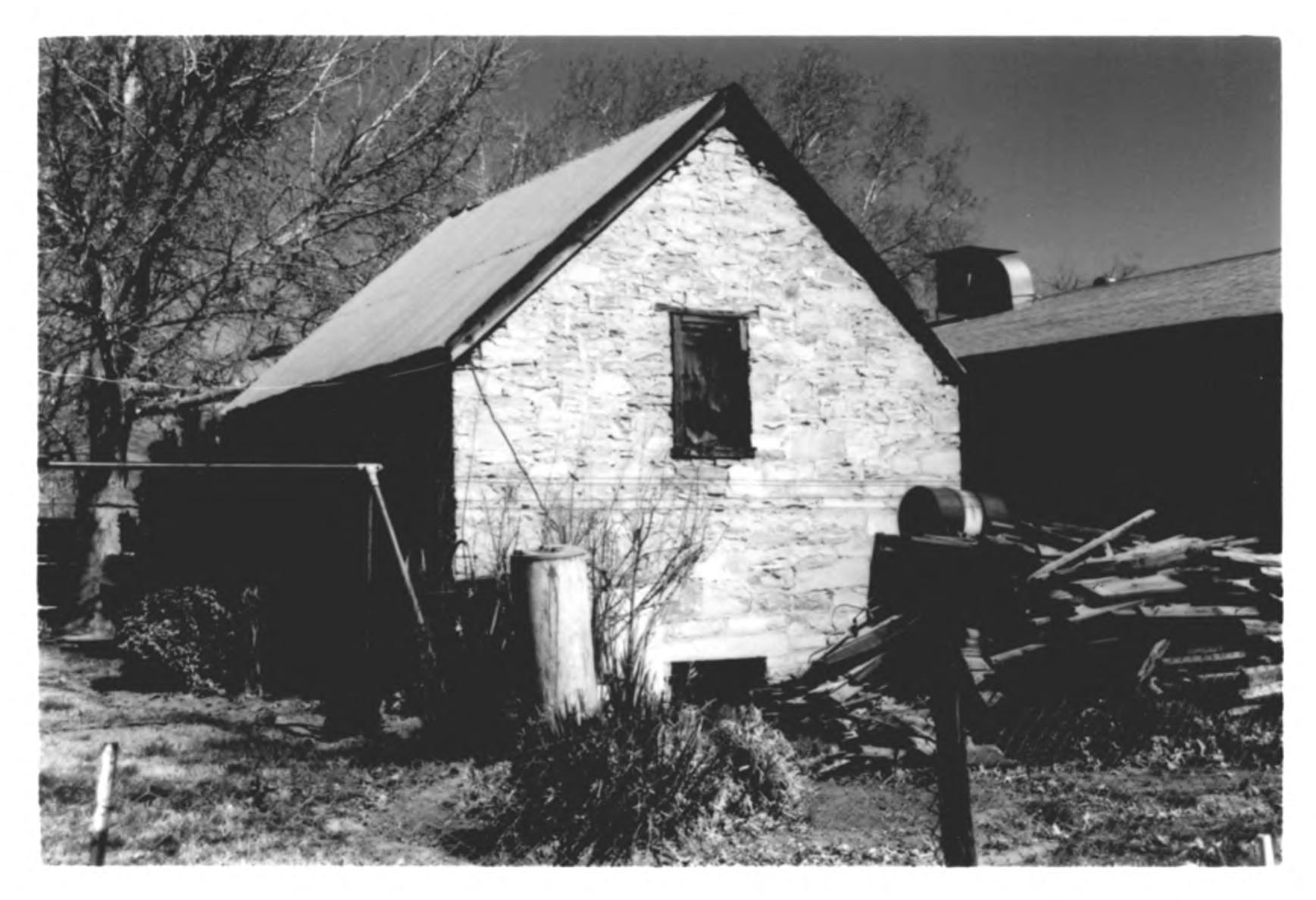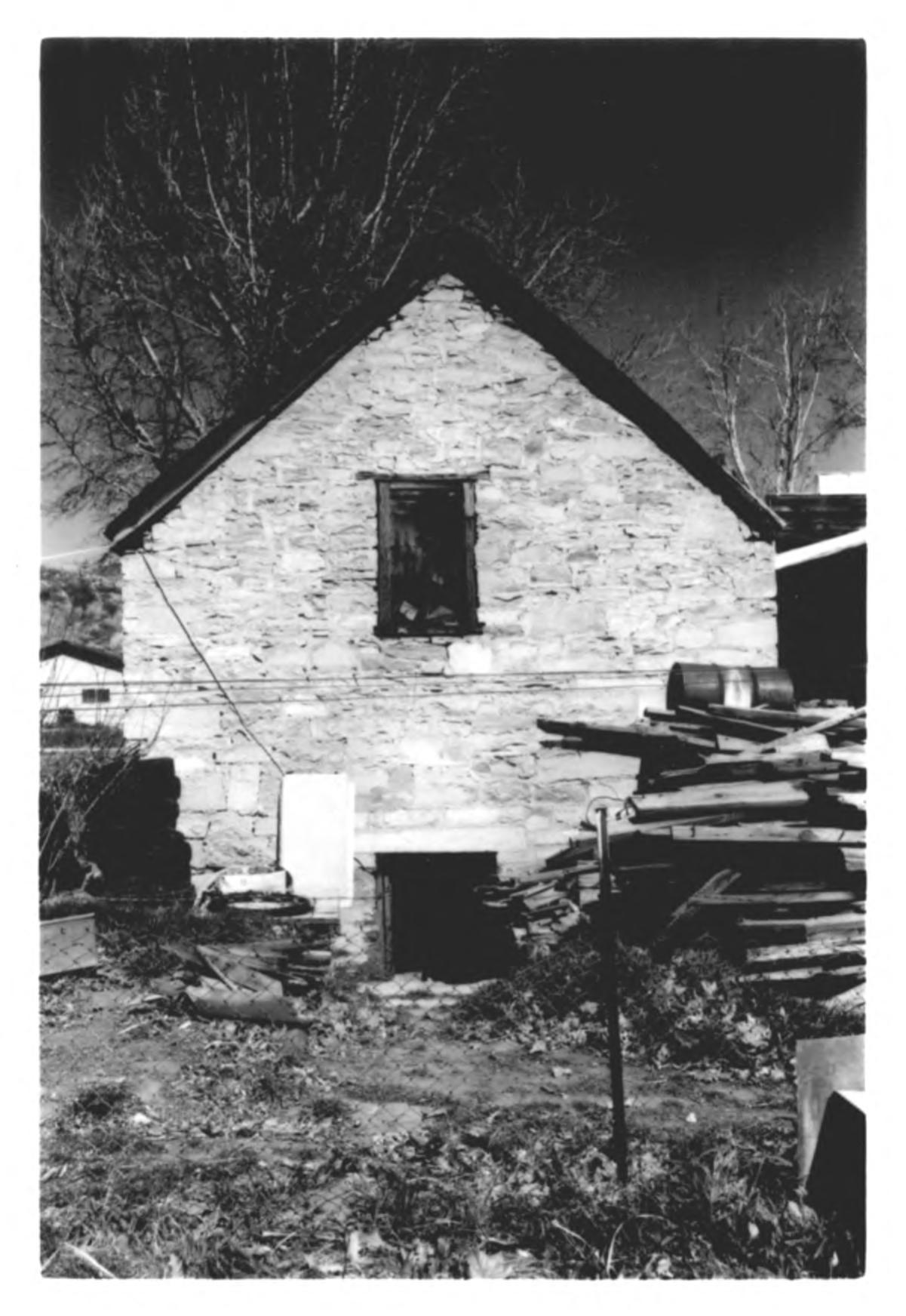
WASHINGTON COUNTY HISTORICAL SOCIETY (Washington County, Utah)
SANTA CLARA TITHING COMPANY
(aka Santa Clara Tithing Granary)
Santa Clara, Utah
LOCATION
3105 Santa Clara DrivaSanta Clara, UT 84765
0.87 acres
BEGINNING NW COR LOT 5 BLK 15 SANTA CLARA TOWN & FIELD SURVEY TH S 12 RDS TH E 6 RDS; TH N 142.5 FT; TH W 65.10 FT; TH N 55.5 FT; TH W 33.90 FT TO P.O.B. ALSO LOT 4 BLK 15 SCT&FS
DESCRIPTION
The Santa Clara Mormon Tithing Granary, built c.1902, is a one-story sandstone building on a raised sandstone foundation with a corrugated metal-covered gable roof. The building is a vernacular design belonging to no particular style or type, that was used for similar outbuildings, mainly in the southern half of the state, during the settlement period. Although the building remains basically unchanged from its original appearance, the setting has changed slightly with the addition of a later store and residence and the removal of the original tithing barn.The granary is not large, measuring 18'x 20', but contains two levels with VA foot-thick limestone walls laid in a random ashlar pattern. The lower level is below grade approximately five feet and is accessed by a limestone-slab stairwell on the south facade lined with local basalt rock laid in a rubble fashion. Originally the stairwell had a wood frame cover over it which became dilapidated and has recently been removed. There is a single window at the upper level on the south facade (approx. 2'x 3') and two ground-level windows (approx. 1'x 3') for the basement, one each on the east and west facades. These have 2" wood lintels, casings, and sills. The upper door has a 2" wood lintel and concrete threshold, and the lower level doorway has a 10" thick sandstone lintel. Corrugated metal now covers the gable roof and the original wood shingles.
The lower interior has a dirt floor and is open with square posts supporting the upper floor joists. Some of the bins which were used for storing potatoes and fruit are also intact. The upper level is open, similar to the lower, and at one time contained bins and compartments for organization and storing of supplies, but these have since been removed. Access to this level is through a single doorway on the east facade approximately two feet above grade, which at one time probably had a stairway constructed of lumber.
The site has changed somewhat since the building was first constructed and used. Approximately twenty feet to the west of the granary is now a house, built in the c. 1960s. The granary is part of the same property as the house. Behind the house and granary remains a large field used for planting, which probably appears much as it did when the granary was first built. To the east of the granary is a small lane for access to the fields behind. On the other side of the lane is a small grocery store built c.1930.
The granary is in good condition and, except for the removal of some of the interior bins and the basement stairwell covering, has been little altered. It is now used for storage.
HISTORY
The Mormon Tithing Granary of the Santa Clara Ward is significant for its association with the "Early Twentieth-Century Development: 1900-1940s" category of the "Historic and Architectural Resources of Santa Clara, Utah," Multiple Property Nomination. Tithing offices and granaries were found in almost every community of the territory from the time the area was settled up until the first couple of decades of the 20th Century. The granaries were used for storing grain and other produce donated by members of the Church of Jesus Christ of Latter-day Saints (LDS or Mormon church) in fulfillment of their tithing obligation. The Santa Clara tithing granary is unique as an example of a post-turn-of-the-century tithing granary in Utah, particularly for a stone granary, of which there were few.The "Early Twentieth-Century Development" period saw little change from the previous period in Santa Clara. Fruit production was the chief occupation and source of income for the residents. The population grew but at a very slow pace. Because of its remoteness and climate, few people were attracted to Santa Clara as a place to live. But families expanded enough to require a larger replacement for the meeting house and the construction of a new school in the early part of the century. The fruit industry expanded greatly as means of transporting the produce improved. Trucks were purchased by some shippers to sell the fruit in out of state markets. Although the railroad never made it to the region, a major highway, the "Arrowhead Trail" was constructed right through Santa Clara in the 1920s. This brought many travelers to the area who bought fruit in the city at roadside stands. With the highway also came increased tourism which brought more business to the area, although mainly to St. George, the largest settlement in the region. Santa Clara thrived on the fruit industry until the lnterstate-15 project bypassed the area in the 1970s.
When the Utah Territory was first settled in 1847 by members of the LDS church, the various communities were governed by precepts directed by the leadership of the church. Although the many settlements were mainly scattered along a four hundred-mile corridor, each one was basically established with the same plan and operated in the same manner to create a pattern of unity. Usually the ward (parish) bishop was the civic and spiritual leader of the community, and largely determined how the affairs in the community were handled.
A basic tenet of the LDS church is the payment of tithing. Tithing, as interpreted by the church, is the practice of contributing 10% of one's income or increase, either in cash or "in kind" (products or service, rather than money). The LDS church located in the Great Basin area to escape constant persecution from communities in the Eastern United States and by so doing largely separated itself from the country's economy. Cash was very scarce among the people who settled here and families were either self-sustaining or bartered for needed commodities. Tithing was paid on an annual basis and throughout the nineteenth century was mostly paid "in kind" by whatever the person produced most. Because a majority of the settlements in Utah were agrarian, this meant paying in grain and produce.
Tithing lots were set up in the center of the towns and, depending on the size of the population, usually consisted of a barn and coops for keeping animals, a granary and cellar for keeping grain and produce, and possibly a tithing office. In most of the settlements managing the tithing lot and tithes was a fulltime responsibility for the bishop. After the donated products and animals were received they were then disbursed to the needy or transported to Salt Lake City via regional offices where they were used or traded for various church needs. The LDS church's women's organization, the Relief Society, also had a program similar to the tithing system. The donations were used for similar purposes, but were distributed according to the Relief Society leaders' discretion. They often had their own granaries, meeting houses, and offices, depending on the circumstances of the community.
The Santa Clara tithing granary was constructed in c.1902 on property which had been purchased by Bishop John G. Hafen on February 13 of the same year for $150 from the Santa Clara Ward Relief Society. The Relief Society apparently had a meeting house and maintained vineyards on some of the property. This they retained after the rest of the property was sold for the use of the tithing lot. Also constructed on the tithing lot was a tithing office and barn which have both been demolished.
The tithing granary had a short life, and was only in use until 1908, when the church discontinued the acceptance of "in kind" contributions as the state became more assimilated into a cash economy. For several years the granary sat vacant until Emil Gubler offered to buy the property from the LDS church in June 1926. A portion of the property was parceled to Adolph Hafen on which to build a grocery store. From the granary, Mr. Gubler removed all but one of the grain bins from the top floor, and the building has been used for storage ever since.
For a tithing granary, the Santa Clara building is fairly unique in its stone composition, particularly for the late date of its construction. Although there are other extant examples of stone granaries in the state, they are not tithing granaries and most were constructed in the nineteenth century. The two most common type of extant tithing granaries in the state are of lumber construction. The first type was of a reverse framing method known as an "inside out" granary because horizontal boards were attached to the inside of a 2"x 4" lumber frame, creating an internal crib in which to store the grain. With the framing on the outside, the weight of the grain could not force off the siding. The second type, not as common, was constructed of stacked 2"x 4" butt-jointed boards, which were spiked at the corners. This method is referred to as "false timbering." These two types are mainly found in the northern part of the state. Although stone outbuildings were common in the in almost all areas of Utah, particularly in the central and southern areas, no extant, stone tithing granaries have been documented, making this building unique particularly for the good condition in which it remains.
PHOTOS
 North and east side of the building (Cory Jensen, March 1998) |
 South and west side of the building (Cory Jensen, March 1998) |

South side of the building (Cory Jensen, March 1998)
Other photos on the web:
Photos from the National Register of Historic Places nomination form
REFERENCES
National Register of Historic Places, Inventory - Nomination FormStory of the restoration of the Santa Clara Tithing Granary Tithing structures recall hardscrabble pioneer days
Article by Brian Passey
The Spectrum, May 18,2017